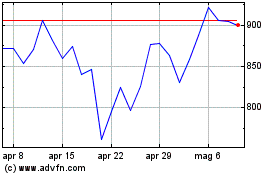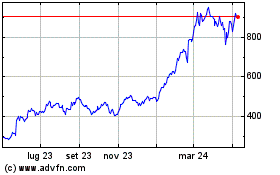COMPUTEX -- NVIDIA and SoftBank Corp.
today announced they are collaborating on a pioneering platform for
generative AI and 5G/6G applications that is based on the NVIDIA
GH200 Grace Hopper™ Superchip and which SoftBank plans to roll out
at new, distributed AI data centers across Japan.
Paving the way for the rapid, worldwide deployment of generative
AI applications and services, SoftBank will build data centers that
can, in collaboration with NVIDIA, host generative AI and wireless
applications on a multi-tenant common server platform, which
reduces costs and is more energy efficient.
The platform will use the new NVIDIA MGX™ reference architecture
with Arm Neoverse-based GH200 Superchips and is expected to improve
performance, scalability and resource utilization of application
workloads.
“As we enter an era where society coexists with AI, the demand
for data processing and electricity requirements will rapidly
increase. SoftBank will provide next-generation social
infrastructure to support the super-digitalized society in Japan,”
said Junichi Miyakawa, president and CEO of SoftBank Corp. “Our
collaboration with NVIDIA will help our infrastructure achieve a
significantly higher performance with the utilization of AI,
including optimization of the RAN. We expect it can also help us
reduce energy consumption and create a network of interconnected
data centers that can be used to share resources and host a range
of generative AI applications.”
“Demand for accelerated computing and generative AI is driving a
fundamental change in the architecture of data centers,” said
Jensen Huang, founder and CEO of NVIDIA. “NVIDIA Grace Hopper is a
revolutionary computing platform designed to process and scale-out
generative AI services. Like with other visionary initiatives in
their past, SoftBank is leading the world to create a telecom
network built to host generative AI services.”
The new data centers will be more evenly distributed across its
footprint than those used in the past, and handle both AI and 5G
workloads. This will allow them to better operate at peak capacity
with low latency and at substantially lower overall energy
costs.
SoftBank is exploring creating 5G applications for autonomous
driving, AI factories, augmented and virtual reality, computer
vision and digital twins.
Virtual RAN With Record-Breaking
ThroughputNVIDIA Grace Hopper and NVIDIA BlueField®-3 data
processing units will accelerate the software-defined 5G vRAN, as
well as generative AI applications, without bespoke hardware
accelerators or specialized 5G CPUs. Additionally, the NVIDIA
Spectrum Ethernet switch with BlueField-3 will deliver a highly
precise timing protocol for 5G.
The solution achieves breakthrough 5G speed on an
NVIDIA-accelerated 1U MGX-based server design, with industry-high
throughput of 36Gbps downlink capacity, based on publicly available
data on 5G accelerators. Operators have struggled to deliver such
high downlink capacity using industry-standard servers.
New Reference ArchitectureNVIDIA MGX is a
modular reference architecture that enables system manufacturers
and hyperscale customers to quickly and cost-effectively build over
a hundred different server variations to suit a wide range of AI,
HPC and NVIDIA Omniverse™ applications.
By incorporating NVIDIA Aerial™ software for high-performance,
software-defined, cloud-native 5G networks, these 5G base stations
will allow operators to dynamically allocate compute resources, and
achieve 2.5x power efficiency over competing products.
“The future of generative AI requires high-performance,
energy-efficient compute like that of the Arm Neoverse-based Grace
Hopper Superchip from NVIDIA,” said Rene Haas, CEO of Arm.
“Combined with NVIDIA BlueField DPUs, Grace Hopper enables the new
SoftBank 5G data centers to run the most demanding compute- and
memory-intensive applications and bring exponential efficiency
gains to software-defined 5G and AI on Arm.”
About SoftBank Corp.Guided by the SoftBank
Group’s corporate philosophy, “Information Revolution – Happiness
for everyone,” SoftBank Corp. (TOKYO: 9434) provides
telecommunications services and combines them with advanced
technologies to develop and operate new businesses in Japan and
globally. By fully harnessing the power of 5G, AI, IoT, Digital
Twin and other key technologies, SoftBank Corp. aims to realize the
“Implementation of Digitalization into Society.” To learn more,
please visit https://www.softbank.jp/en/
About NVIDIASince its founding in 1993, NVIDIA
(NASDAQ: NVDA) has been a pioneer in accelerated computing. The
company’s invention of the GPU in 1999 sparked the growth of the PC
gaming market, redefined computer graphics, ignited the era of
modern AI and is fueling the creation of the industrial metaverse.
NVIDIA is now a full-stack computing company with data-center-scale
offerings that are reshaping industry. More information at
https://nvidianews.nvidia.com/.
For further information, contact:Cliff
EdwardsNVIDIA Corporation+1-415.699.2755cliffe@nvidia.com
Certain statements in this press release including, but not
limited to, statements as to: the benefits, performance, impact and
availability of our products and technologies, including NVIDIA
Grace Hopper, BlueField-3, NVIDIA MGX, NVIDIA Spectrum and NVIDIA
Aerial software; NVIDIA’s collaboration with SoftBank, including
the benefits and impact thereof; the demand for data processing and
electricity requirements rapidly increasing; demand for accelerated
computing and generative AI driving a fundamental change in the
architecture of data centers; and the future of generative AI
requiring high-performance, energy-efficient compute are
forward-looking statements that are subject to risks and
uncertainties that could cause results to be materially different
than expectations. Important factors that could cause actual
results to differ materially include: global economic conditions;
our reliance on third parties to manufacture, assemble, package and
test our products; the impact of technological development and
competition; development of new products and technologies or
enhancements to our existing product and technologies; market
acceptance of our products or our partners' products; design,
manufacturing or software defects; changes in consumer preferences
or demands; changes in industry standards and interfaces;
unexpected loss of performance of our products or technologies when
integrated into systems; as well as other factors detailed from
time to time in the most recent reports NVIDIA files with the
Securities and Exchange Commission, or SEC, including, but not
limited to, its annual report on Form 10-K and quarterly reports on
Form 10-Q. Copies of reports filed with the SEC are posted on the
company's website and are available from NVIDIA without charge.
These forward-looking statements are not guarantees of future
performance and speak only as of the date hereof, and, except as
required by law, NVIDIA disclaims any obligation to update these
forward-looking statements to reflect future events or
circumstances.
© 2023 NVIDIA Corporation. All rights reserved. NVIDIA, the
NVIDIA logo, BlueField, NVIDIA Aerial, NVIDIA Grace Hopper, NVIDIA
MGX and NVIDIA Omniverse are trademarks and/or registered
trademarks of NVIDIA Corporation in the U.S. and other countries.
SoftBank, the SoftBank name and logo are registered trademarks or
trademarks of SoftBank Group Corp. in Japan and other countries.
Other company and product names may be trademarks of the respective
companies with which they are associated. Features, pricing,
availability, and specifications are subject to change without
notice.
Grafico Azioni NVIDIA (NASDAQ:NVDA)
Storico
Da Mar 2024 a Apr 2024

Grafico Azioni NVIDIA (NASDAQ:NVDA)
Storico
Da Apr 2023 a Apr 2024
